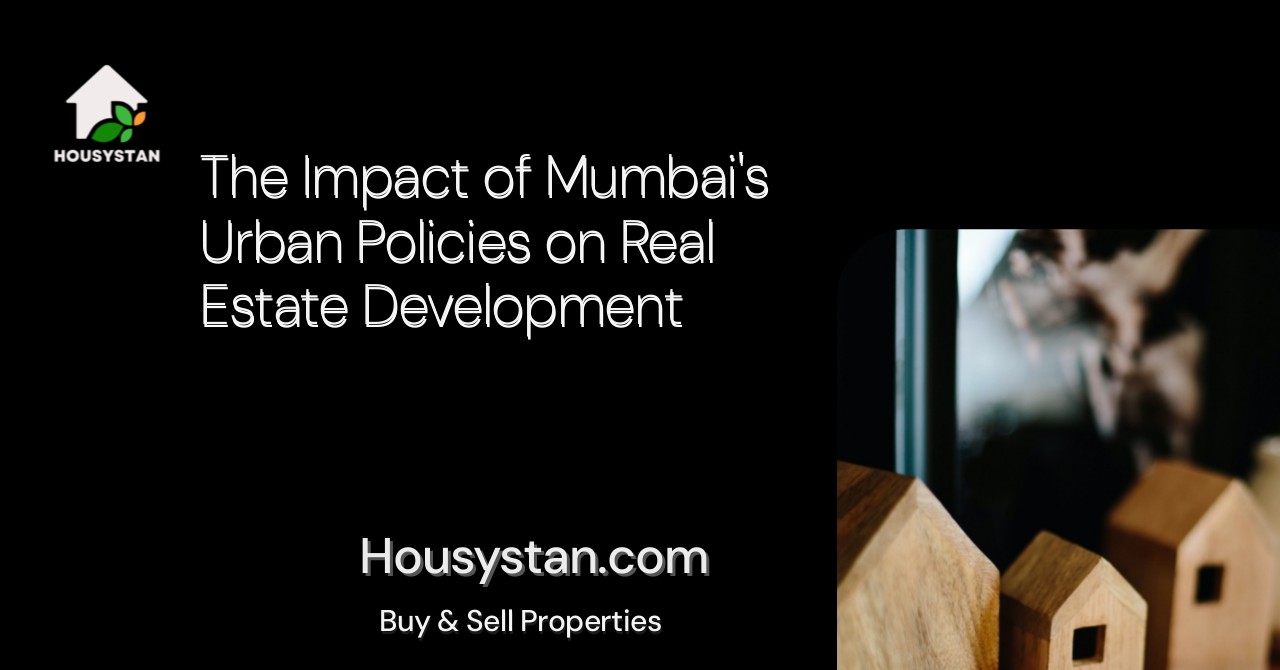The Impact of Mumbai's Urban Policies on Real Estate Development
Read latest blogs and articles from Housystan

The Information mentioned here was last updated on:
13/1/2026The Impact of Mumbai's Urban Policies on Real Estate Development
Mumbai, a bustling metropolis and the financial hub of India, is renowned for its dynamic real estate market. This market is profoundly influenced by urban policies that shape the skyline of this cosmopolitan city. Understanding the intricate relationship between urban policies and real estate development in Mumbai is essential for investors, developers, and residents alike.
1. The Evolution of Urban Policies in Mumbai
- Verified Tenants/Buyers
- Unlimited Property Listing
- Zero subscription/charges fee
Mumbai's urban policies have evolved significantly over the years, responding to the city's ever-growing demands:
- Development Control Regulations (DCR): These regulations are fundamental in shaping Mumbai's urban environment. They dictate land use, building heights, and floor space index (FSI). Changes in these regulations can dramatically alter real estate landscapes.
- The Rent Control Act: Originally implemented to protect tenants, the Rent Control Act has historically impacted property development by limiting rental income growth potential. This has sometimes discouraged the construction of rental properties in favor of for-sales units.
- Slum Rehabilitation Authority (SRA): With over half of Mumbai's population living in slums, SRA policies aim to redevelop these areas. This initiative significantly impacts real estate development, as it opens up land for new projects while aiming to improve living conditions for slum dwellers.
2. Key Urban Development Plans
Mumbai's government has introduced various development plans aimed at streamlining urban growth:
- Mumbai Development Plan 2034: This ambitious plan focuses on boosting FSI in prime locations, allowing for taller buildings that maximize the use of land. It includes strategies for affordable housing and infrastructure improvements, both crucial for sustainable urban development.
- Coastal Road Project: Aimed at reducing traffic congestion, this project is expected to make certain real estate areas more accessible and appealing, potentially increasing property values in these locations.
- Metro Expansion: The expansion of Mumbai's metro network is a game-changer for commuting in the city. Properties close to metro stations are likely to see a surge in demand, influencing real estate prices positively.
3. Challenges and Opportunities in Mumbai's Real Estate Market
Urban policies can present both challenges and opportunities for real estate development in Mumbai:
- Land Scarcity: With limited land available for development, property prices remain high. Urban policies that increase FSI or promote redevelopment can help mitigate this issue by allowing more high-rise construction.
- Affordable Housing Initiatives: Policies promoting affordable housing are vital in a city like Mumbai, where a significant portion of the population struggles with housing costs. Developers are incentivized to include affordable units in their projects, easing the housing crisis while generating new opportunities for investment.
- Redevelopment of Old Buildings: Mumbai is home to many aging structures. Policies favoring the redevelopment of such buildings can rejuvenate neighborhoods and provide modern housing options, attracting investors and residents.
4. Environmental Considerations in Urban Policy
Sustainable development is a growing focus in Mumbai's urban policies:
- Green Building Initiatives: Encouraging eco-friendly building practices not only helps the environment but can also be financially advantageous for developers in the long term through energy savings.
- Flood Management: With recurring monsoon flooding, urban development policies that incorporate flood resilience are critical. This includes better drainage systems and construction techniques that prepare new developments to withstand heavy rainfalls.
5. The Role of Technology and Innovation
Technological advancements are changing the landscape of real estate development:
- Smart City Initiatives: These initiatives aim to integrate technology into urban infrastructure, improving the quality of life and making areas more attractive for real estate investments.
- Digital Platforms: Using technology to improve transparency and efficiency in real estate transactions supports investor confidence and attracts more players to the market.
6. Policy Implementation and Its Effects
While Mumbai's policies are ambitious and forward-thinking, their implementation can sometimes pose challenges:
- Bureaucratic Delays: Complex approval processes can delay projects, affecting timelines and costs for developers. Streamlining these procedures is crucial for promoting a healthier real estate market.
- Infrastructure Development: Ensuring timely infrastructure improvements, like roads and utilities, is vital for the success of residential and commercial projects that depend on them.
7. Future Prospects for Mumbai's Real Estate
The trajectory of Mumbai's real estate market is closely tied to its urban policies:
- Policy Reforms: Ongoing reforms aiming to simplify regulations, boost housing affordability, and improve infrastructure are expected to sustain the momentum in real estate development.
- Investment Potential: Mumbai remains a lucrative destination for both domestic and international investors. Continuous updates and clarification of policies can bolster investor confidence and drive more investments into the city.
- Sustainable Growth: As Mumbai continues to grow, the focus on sustainable practices will be essential to ensure that development is both economically and environmentally viable.
In understanding the impact of Mumbai's urban policies on real estate, stakeholders can navigate the complexities of this vibrant market and capitalize on the opportunities it presents. By fostering a balanced approach that considers regulatory frameworks, market demands, and sustainable practices, Mumbai is poised to continue its evolution as a global city. With the interplay of policy, development, and innovation, Mumbai's skyline will continue to tell a story of transformation and resilience.